We contemplated a trip to Zermatt to see Switzerland’s most famous mountain, but instead opted for the rural region of Appenzell, high up in the Alps of eastern Switzerland. We had read before arriving that a visit to Appenzell is like turning back time and that it was! Appenzell is Switzerland’s most traditional region; all elections and parliamentary business are still publicly debated in the historic village square Landsgemeindeplatz and voting is done by a public show of hands. Women weren’t even allowed to vote until 1991.
 But it is the tradition that make Appenzell unique and charming. The colorfully painted chalets triggered memories of what I imagined the villages of many of my favorite childhood fairy tales to look like. As we arrived, there was a chalet adorned with gnomes and a life-size teddy bear blowing bubbles that floated up into the cloudless blue sky. Just as I turned to snap a photo, a carriage driven by two horses dressed to the nines in their feathered headdresses came clapping down the cobbled lane. The carriage was on its way to pick up a beautiful bride, who looked like the very Cinderella from Disney fairy tales, at the St. Mauritius church just around the corner.
But it is the tradition that make Appenzell unique and charming. The colorfully painted chalets triggered memories of what I imagined the villages of many of my favorite childhood fairy tales to look like. As we arrived, there was a chalet adorned with gnomes and a life-size teddy bear blowing bubbles that floated up into the cloudless blue sky. Just as I turned to snap a photo, a carriage driven by two horses dressed to the nines in their feathered headdresses came clapping down the cobbled lane. The carriage was on its way to pick up a beautiful bride, who looked like the very Cinderella from Disney fairy tales, at the St. Mauritius church just around the corner.
The richly decorated series of panels and emblems on each of Appenzell’s buildings are representative of its history. A Hershey bar emblem stands alongside the gnomes and bubble-blowing teddy bear atop the Bazar Hersche as a reminder that Milton Hershey’s family came from Appenzell and milk chocolate was founded here.
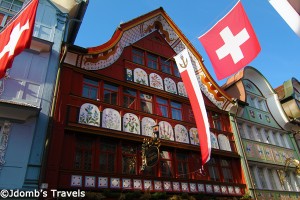
Another small church called Heiligkreuzkapelle on the main street, Hauptgasse, was rebuilt after a fire devastated the village in 1560. Its stained glass windows depict the five sorrowful mysteries of the rosary.
Cows are the center of Appenzell culture. Not only did we find shops selling the famously smelly Appenzeller cheese made from cow milk and a secret mixture of 42 herbs, we also saw huge cow bells on elaborately decorated collars hanging in store windows. The various bakeries in the village display freshly baked treats like gingerbread filled with pears or marzipan, of course adorned with a maripan cow on top!
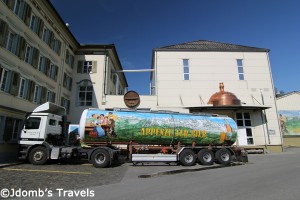
Where to Eat
There are a number of restaurants in the village. We enjoyed an Appenzeller fondue at Cafe Flade with a local Swiss white wine one evening. Another evening we dined at Hörnli Turi’s Rösti-Huus where the menu features various meat and vegetable dishes all prepared with the famous Rösti (sort of like hash browns but better!).
Where to Stay
We really enjoyed the Hotel Hecht centrally located in the pedestrian zone of the village. All the rooms have been newly renovated and ours was quite nicely sized with beautiful hard wood floors and large windows that opened to let the cool breeze in. The bathroom was large and modern. There is free parking nearby, free wifi, breakfast included, and it is dog friendly. Note that there is no air conditioning.
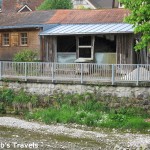
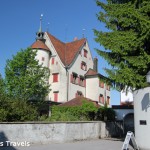


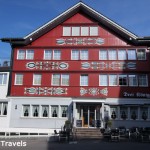
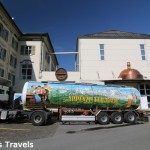
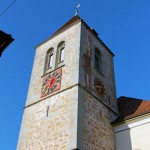
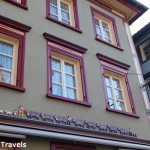
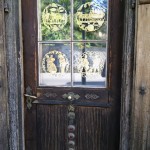
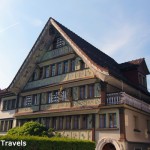

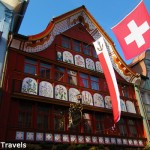
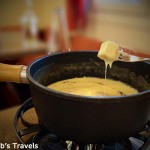
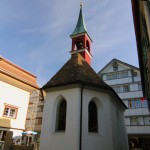
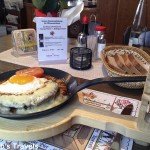
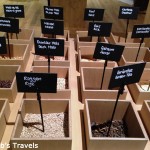
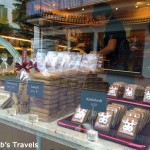

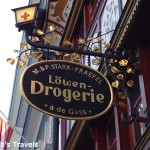
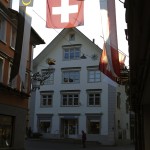
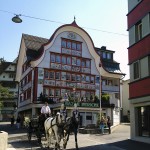


Rob says
I really..Really want to go to Switzerland!!.
Jennifer Dombrowski says
Hi Rob,
Thanks for your comment. I’m convinced this is where happy cows really come from! Keep on eye on our website for even more, including hiking to an amazing lake and mountain chalet that serves only ingredients grown locally, all this week.
Gertrude Toll says
I have a question about Photo #5. What is this building? I have a postcard from the 1930s but it doesn’t say what the building is
Jennifer Dombrowski says
It’s called the Concordia House and is located on Engelgasse. The gabled house dates from the 17th century, but the decorated series of panels covering the entire southern façade was created by August Schmid in 1930. So it would make sense that the Concordia House with its new artwork murals would be on postcards from Appenzell in the 1930s! That’s amazing you have a postcard from nearly 100 years ago!